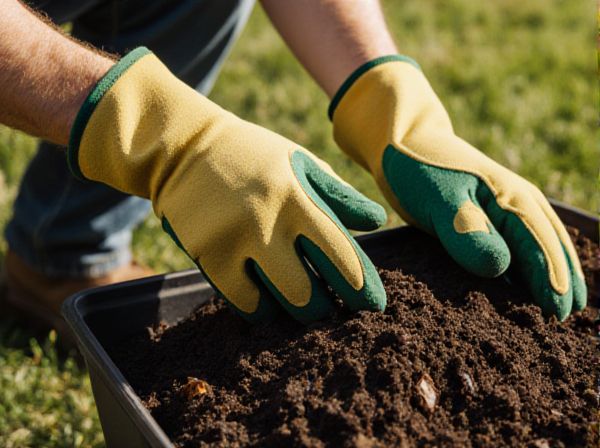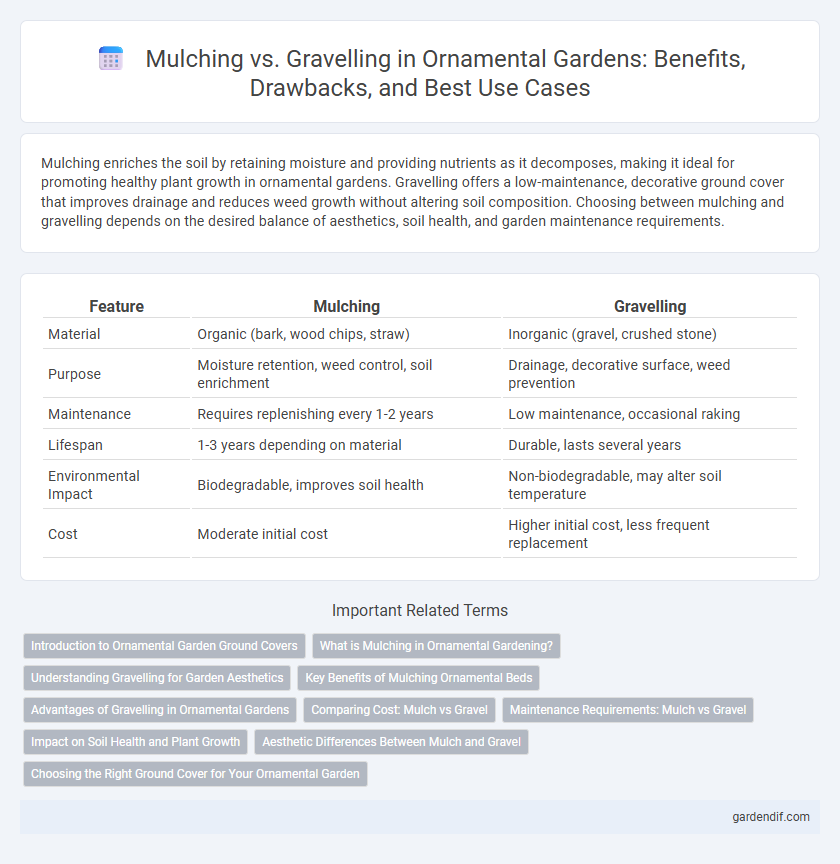
Mulching vs Gravelling Illustration
Mulching enriches the soil by retaining moisture and providing nutrients as it decomposes, making it ideal for promoting healthy plant growth in ornamental gardens. Gravelling offers a low-maintenance, decorative ground cover that improves drainage and reduces weed growth without altering soil composition. Choosing between mulching and gravelling depends on the desired balance of aesthetics, soil health, and garden maintenance requirements.
Table of Comparison
| Feature | Mulching | Gravelling |
|---|---|---|
| Material | Organic (bark, wood chips, straw) | Inorganic (gravel, crushed stone) |
| Purpose | Moisture retention, weed control, soil enrichment | Drainage, decorative surface, weed prevention |
| Maintenance | Requires replenishing every 1-2 years | Low maintenance, occasional raking |
| Lifespan | 1-3 years depending on material | Durable, lasts several years |
| Environmental Impact | Biodegradable, improves soil health | Non-biodegradable, may alter soil temperature |
| Cost | Moderate initial cost | Higher initial cost, less frequent replacement |
Introduction to Ornamental Garden Ground Covers
Mulching provides organic ground covers that improve soil moisture retention and enrich nutrient content, promoting healthy ornamental plant growth. Gravelling offers inorganic, decorative ground covers that enhance drainage and create a clean, low-maintenance landscape aesthetic. Both methods serve functional and visual purposes in ornamental garden designs by controlling weeds and defining plant boundaries.
What is Mulching in Ornamental Gardening?
Mulching in ornamental gardening involves applying a protective layer of organic or inorganic material around plants to conserve soil moisture, regulate temperature, and suppress weeds. Common mulching materials include bark chips, compost, straw, and pine needles, which enhance soil fertility and promote healthy root growth. Proper mulching improves aesthetic appeal while maintaining plant health and reducing maintenance efforts.
Understanding Gravelling for Garden Aesthetics
Gravelling enhances garden aesthetics by providing a polished, low-maintenance surface that improves drainage and suppresses weed growth. Unlike mulching, gravelling offers long-lasting durability and a range of decorative stone options to complement various garden styles. Selecting appropriate gravel size and color plays a crucial role in achieving the desired visual impact and functionality.
Key Benefits of Mulching Ornamental Beds
Mulching ornamental beds enhances soil moisture retention, suppresses weed growth, and regulates soil temperature, promoting healthier plant roots and vibrant blooms. Organic mulches decompose over time, enriching the soil with essential nutrients that gravelling cannot provide. Mulching also improves the aesthetic appeal of garden beds by creating a uniform, natural appearance that complements ornamental plants.
Advantages of Gravelling in Ornamental Gardens
Graveling in ornamental gardens enhances drainage, preventing waterlogging and promoting healthier plant roots. It offers long-term durability with minimal maintenance compared to mulching, reducing the need for frequent replacement. Gravel also adds aesthetic appeal through varied textures and colors, complementing garden designs while deterring weed growth effectively.
Comparing Cost: Mulch vs Gravel
Mulching typically costs between $30 and $60 per cubic yard, making it a more affordable option for large garden areas compared to gravel, which averages $50 to $100 per ton. Gravel installation includes extra expenses such as weed barrier fabric and labor, driving up total costs beyond the initial material price. Mulch decomposes over time, requiring regular replenishment, while gravel is more durable but may necessitate periodic raking or refilling to maintain appearance and function.
Maintenance Requirements: Mulch vs Gravel
Mulching requires regular replenishment, typically every 1-2 years, to maintain effectiveness and prevent decomposition, while gravel is more durable and needs minimal upkeep, mostly occasional raking to remove debris. Mulch improves soil moisture retention and nutrient content but can attract pests and mold if not maintained properly. Gravel provides excellent drainage and weed suppression but may require periodic weed control and occasional top-up to maintain coverage.
Impact on Soil Health and Plant Growth
Mulching improves soil health by retaining moisture, regulating temperature, and adding organic matter that enriches soil nutrients and supports beneficial microbial activity. Gravelling, while enhancing aesthetics and preventing weed growth, can impede water infiltration and soil aeration, potentially leading to soil compaction and reduced root development. Choosing mulch over gravel promotes healthier plant growth through better soil structure and nutrient availability.
Aesthetic Differences Between Mulch and Gravel
Mulch offers a rich, organic texture and deep, earthy tones that enhance garden beds with a natural, soft appearance, while gravel provides a clean, modern look with its varied colors and shapes creating crisp, defined borders. Mulch gradually decomposes, enriching soil and blending seamlessly with plant life, whereas gravel maintains consistent color and structure, contributing to a sleek, minimalist aesthetic. Selecting between mulch and gravel ultimately depends on whether a warm, natural ambience or a polished, contemporary design is desired for ornamental landscaping.
Choosing the Right Ground Cover for Your Ornamental Garden
Mulching provides essential nutrients, retains soil moisture, and suppresses weeds, making it ideal for flower beds and delicate ornamental plants. Gravelling offers excellent drainage and low maintenance, perfect for pathways and drought-tolerant garden areas that require sturdy, decorative ground cover. Selecting the right ground cover depends on your garden's water needs, plant types, and aesthetic preferences to enhance both health and beauty.
Mulching vs Gravelling Infographic

 gardendif.com
gardendif.com